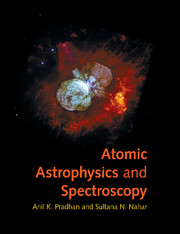Book contents
- Frontmatter
- Contents
- Preface
- Acknowledgements
- 1 Introduction
- 2 Atomic structure
- 3 Atomic processes
- 4 Radiative transitions
- 5 Electron–ion collisions
- 6 Photoionization
- 7 Electron–ion recombination
- 8 Multi-wavelength emission spectra
- 9 Absorption lines and radiative transfer
- 10 Stellar properties and spectra
- 11 Opacity and radiative forces
- 12 Gaseous nebulae and H II regions
- 13 Active galactic nuclei and quasars
- 14 Cosmology
- Appendix A Periodic table
- Appendix B Physical constants
- Appendix C Angular algebra and generalized radiative transitions
- Appendix D Coefficients of the fine structure components of an LS multiplet
- Appendix E Effective collision strengths and A-values
- References
- Index
3 - Atomic processes
Published online by Cambridge University Press: 05 June 2012
- Frontmatter
- Contents
- Preface
- Acknowledgements
- 1 Introduction
- 2 Atomic structure
- 3 Atomic processes
- 4 Radiative transitions
- 5 Electron–ion collisions
- 6 Photoionization
- 7 Electron–ion recombination
- 8 Multi-wavelength emission spectra
- 9 Absorption lines and radiative transfer
- 10 Stellar properties and spectra
- 11 Opacity and radiative forces
- 12 Gaseous nebulae and H II regions
- 13 Active galactic nuclei and quasars
- 14 Cosmology
- Appendix A Periodic table
- Appendix B Physical constants
- Appendix C Angular algebra and generalized radiative transitions
- Appendix D Coefficients of the fine structure components of an LS multiplet
- Appendix E Effective collision strengths and A-values
- References
- Index
Summary
Spectral formation depends on a variety of intrinsic atom–photon interactions. In addition, external physical conditions, such as temperature, density and abundances of elements determine the observed spectrum. As described in later chapters, spectral analysis is therefore often complicated and it is difficult to ascertain physical effects individually (and even more so collectively). The main aim of this chapter is to provide a unified picture of basic atomic processes that are naturally inter-related, and may be so considered using state-of-the-art methods in atomic physics. A quantum mechanical treatment needs to take the relevant factors into account. An understanding of these is essential, in order to decide the range and validity of various theoretical approximations employed, and the interpretation of astrophysical observations. From a practical standpoint, it is necessary to determine when and to what extent a given effect or process will affect spectral lines under expected or specified physical conditions.
For example, at low temperatures and densities we may expect only the low-lying atomic levels to be excited, which often give rise to infrared (IR) and optical forbidden emission lines. But the presence of a background ultraviolet (UV) radiation field from massive young stars in star-forming regions of molecular clouds (e.g., the Orion Nebula discussed in Chapter 12), may excite low-lying levels via UV absorption to higher levels and subsequent radiative cascade of emission lines that would appear not only in the UV but also contribute to the intensities of the IR/optical lines.
- Type
- Chapter
- Information
- Atomic Astrophysics and Spectroscopy , pp. 46 - 71Publisher: Cambridge University PressPrint publication year: 2011



